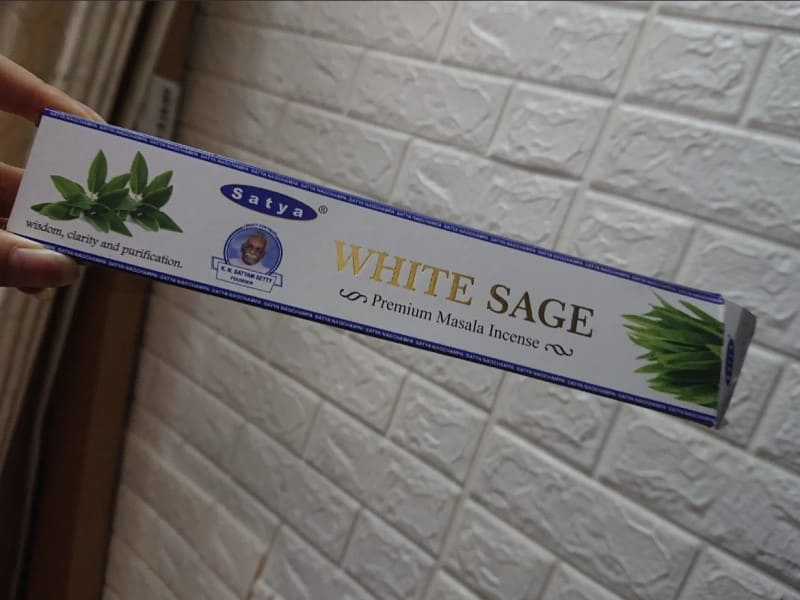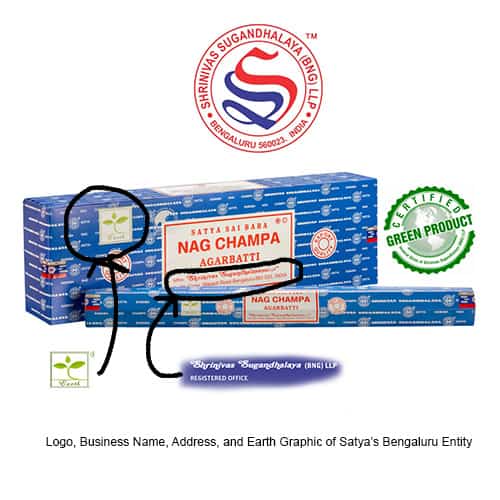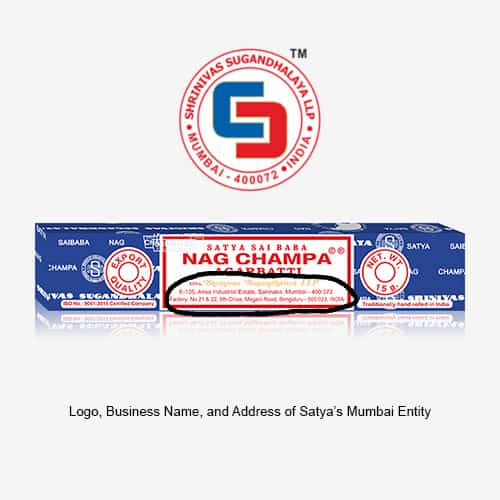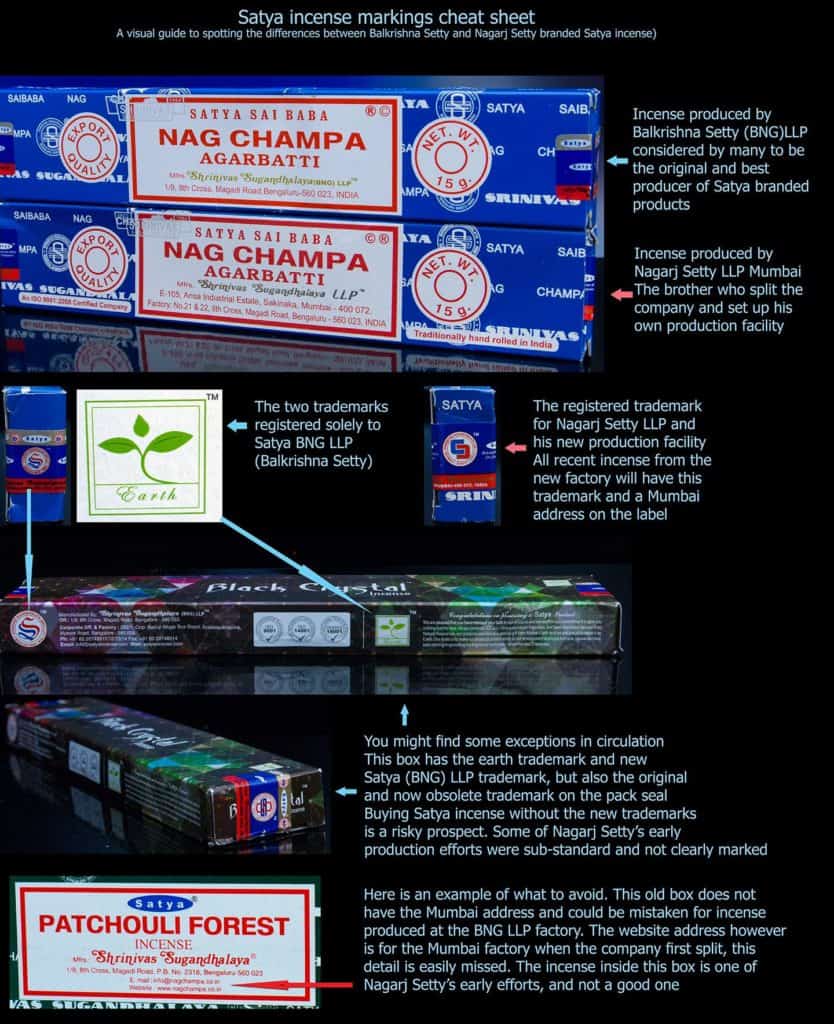Satya is a very popular incense brand best known for its Nag Champa and Super Hit incense sticks. In a weird turn of events, as I was combing through research about this company, I learned that there are two Satya incense companies using very similar packaging, which confuses customers.
Natural ingredients, like tree barks, resins, and other botanical matter are the ingredients used to hand roll Satya incense from one entity, making it 100% natural. The other Satya adds synthetic fragrance oils to its incense formula. This means the second one is not completely natural.
Whether purchasing by mail or in person, you don’t always know which Satya you’ll get. In this article, I’ll dive more into Satya incense specifics and even mention ways to determine which Satya is 100% natural incense.

Satya Incense: A Brief Company History
In 1964, K. N. Satyam Setty founded Satya’s parent company, Shrinivas Sugandhalaya. He wanted to share his love and passion for scents with the world.
Setty was drawn to the traditional masala method that historical monks used to hand roll their incense as it’s been proven to have a more lasting and potent fragrance.
Founder, K. N. Satyam Setty, passed away in 1999 leaving the company to his two sons.
The younger son was heavily involved in the production side of the business, working closely with his father to maintain and produce fragrance recipes. The older son worked in the sales and marketing department.
Setty’s sons had a falling out and divided the company after a dispute about Satya’s manufacturing process. The older brother, K. S. Nagraj Setty, wanted to incorporate machinery into the manufacturing process in order to increase their output, and thus, sales. But the younger son, K. S. Balakrishna Setty, disagreed.
In 2014, Indian courts granted both brothers entitlement to use of the Satya name in trade. Since the older brother worked in Satya’s sales and marketing department based in Mumbai when his father was alive, that is where he set up office for his branch of the business. Balakrishna Setty remained in facilities south of Mumbai.
Now there are two Satyas marketing some overlapping products that are made using different recipes. The two brothers are still battling in the courts for trademark rights in the United States. See the PDF links.
- Shrinivas Sugandhalaya (BNG) LLP vs Shrinivas Sugandhalaya LLP court document PDF
- Petition Appendix PDF
Shrinivas Sugandhalaya (BNG) LLP
Based on my research, K. S. Balakrishna Setty is the founder’s youngest son and runs the originally formed Satya business as his father did, using all of the original recipes and traditional hand rolling production methods. Trained by his father, Balakrisha Setty, formulated the Super Hit recipe, which is also widely popular.
The company continues to grow and is now distributed in 45 countries. In 2014, they opened a new manufacturing facility in Bengaluru, India, which is the capital of Karnataka. In the three production facilities there, multi-generational women artisans hand roll masala incense sticks in a safe work environment while earning fair wages.
Shrinivas Sugandhalaya LLP
This is the Mumbai business that is run by the older brother, Nagraj.
Although it has been frequently documented that the Mumbai location uses technologically advanced methods of making their incense, their recent advertising and website copy explains a hand rolled process. It appears that their masala incense: Nag Champa, Super Hit, and Satya Natural, plus a couple others are hand rolled and their remaining fragrances are primarily made by machine.
For reasons I’ll mention later on, I do not think their incense is 100% natural.
Satya Incense Review: The Original Nag Champa
As explained in this older article, masala incense (also called flora incense) starts as natural raw ingredients in powder form. Essential oils are mixed in and with a botanical binder, a paste is formed. This mixture is then rolled around a bamboo stick, sprinkled with more powder, and then left to dry.
Different combinations of ingredients produce unique scent recipes. Nag Champa incense was originally developed by the founder of Satya. It was popularized in the 1960’s and 1970’s and is the scent most lovingly associated with daily incense burning.
Since the Bengaluru location maintains the old recipes that customers most associate with “original nag champa incense,” I am going to focus on that version.
1. Satya Nag Champa Incense Sticks
- Bangalore ( BNG ) Nag Champa Argarbatti 250 grams
- Includes Govinda incense holder
- Hand rolled incense, Non Toxic, Free from Alcohol, not tested on Animals.
- Govinda Handcrafted incense holder from real wood
“Nag” means snake and “Champa” means flower, so the translated name of this incense is, “Snake Flower.” Satya’s Nag Champa blend is the “world’s most commercially successful incense blend.” What is it about Nag Champa and Super Hit incense that makes them a customer favorite?
The Nag Champa fragrance originated in India. Its main fragrant ingredient is the champaca flower that is cultivated in South and Southeast Asia, extending to some portions of East Asia as well.
Champaca is a flowering tree that’s part of the magnolia family. Its creamy blossoms are highly fragrant and its wood is often used for furniture and construction. It’s an earthy blend that evokes positivity.
Nag champa is a combination of herbs, essential oils, and floral extracts. The natural ingredients help cleanse the air and create a relaxing atmosphere in preparation for meditation. This scent also has a nostalgic hold on many of its customers that remember burning this incense decades ago. But many newcomers instantly fall in love with this woody but floral recipe.
Since each stick is rolled by hand, they can vary slightly in size. Because of this, you will often see them sold by weight instead of the number of sticks. This box is 250 grams, which is approximately 250 sticks of incense.
Pros
- All natural ingredients
- Hand rolled using traditional methods
- Original Nag Champa scent you’re familiar with
- Nice, balanced fragrance, not too strong
- This one box will last for months
Cons
- You have to pay attention to the packaging to make sure you have the original scent
2. Satya Super Hit Incense Sticks
- This is a bundled product that includes Super Hit incense of Satya Bangalore ( BNG ) incense and Govinda incense holder.
- Incense Kit: This bundle includes 1 box of incenses. There are 12 packets in each box. Each packet has 15 grams in it ( Sold by weight ). Incense...
- HAND-ROLLED AND NON-TOXIC: Our fragrance sticks are made of natural ingredients like essential oils, gum, and wood. They are hand-rolled with care in...
- ELEVATE YOUR SPIRIT: The unique fragrances from Satya Sai Baba have a wide range of uses apart from meditation and prayers. Light the incense to relax...
K. S. Balakrishna Setty developed Satya’s SuperHit recipe. It’s also made of wood bark, fragrant flowers, herbs, essential oils, and resins.
This bundle includes:
- 180 grams (approximately 180 incense sticks)
- Govinda incense stick holder
SuperHit smells sweeter and more floral than Nag Champa, but it’s still refreshing and uplifting. Some people describe it as smelling like cookies and cream ice cream or the taro root vegetable.
Others describe the sweetness being similar to honey and vanilla. Floral notes smell similar to jasmine and magnolia flowers.
Clearly everyone has their own interpretation of the scent as fragrance is subjective. But one difference that is clear across all customer feedback is that the SuperHit recipe that’s made by the Mumbai location smells more like perfume or bath soap. Most customers prefer the BNG version because, while it is sweeter, it’s just the right amount of sweetness – not too overwhelming.
Pros
- Natural raw materials
- Masala production method
- Sweeter floral fragrance
Cons
- You have to pay attention to the packaging to make sure you have the original scent
- What To Consider Before Buying Satya Incense
What To Consider Before Buying Satya Incense
While not all of the Bengaluru and Mumbai incense fragrances mirror one another, the three most popular original Satya scents are the same for both companies:
- Satya Sai Baba Nag Champa
- Satya Super Hit
- Satya Natural
This is the root of all of the confusion regarding inconsistent quality. Customers across the globe have noticed a marked difference between the two Satyas, especially when the company first split.
Since the younger brother worked more closely on the production end prior to his father’s death, he was able to maintain the production output, keeping all of his recipes the same.
The older brother, at the Mumbai location, initially released inferior incense. Even though his recipes have improved over the years, the overwhelming response is that Satya incense from Mumbai is more potent, but not in a good way.
There is nothing inherently wrong with the Mumbai incense, it simply doesn’t smell the same as the old recipes even though it is marketed as “authentic” Satya incense. And I think the marketing piece is what infuriates many loyal customers.
They feel duped and manipulated by the Mumbai Satya. If you prefer the older recipes, there are some ways that you can avoid feeling betrayed.
When purchasing Satya incense, if you pay close attention to the packaging, you will notice differences that can offer you some hints about where the incense may have originated.
Satya Incense: Real, Fake, or Something Else?

This is the question that many Satya customers ask themselves when they’re opening a new box of Satya incense. Since there are Satya counterfeits out there that are not made by either of the Setty brothers, it’s a valid question.
Usually the packaging for the counterfeit Satya incense has lots of spelling errors, or really blurry images, and they do not have any seals on either end of the box. These fakes are a lot easier to spot.
Distinguishing between the brothers’ packaging, though, is a task. For sake of clarity, I’m going to refer to Satya incense made in Bengaluru as the “real” Satya because it uses the original recipes and production methods.
Satya incense made in Mumbai is not fake because the older brother has legal rights to use the mark. But it does fall into the “something else” category because his recipes are not the same.
Also, I will only reference Nag Champa, SuperHit, & Natural because these are the only three incense types that I’ve found to overlap and cause confusion.
The blue oval registered trademark above is legally used by both Setty brothers.
Satya Bengaluru vs Satya Mumbai: Packaging Distinctions
If you are feeling nostalgic and want the Nag Champa from times past, then you want to purchase incense made in Bengaluru, sold by Shrinivas Sugandhalaya (BNG) LLP.
If you have never burned Nag Champa before and/or are fond of stronger, more perfume-like incense fragrances, you might like Nag Champa made by Satya’s Mumbai location, Shrinivas Sugandhalaya LLP.
This is the primary difference in packaging – the manufacturing location printed on each box.
Here are packaging examples of each legal Satya entity:


So, if you want the “real” Satya, look for “BNG” and the Earth trademark. Also, the Bengaluru location has a much shorter manufacturer address. The Mumbai location includes both a Mumbai and Bengaluru address, which feels shady.
Another Satya customer created the graphic below and shared it in a forum:
So in terms of packaging, here’s what to look out for if you want the original recipes:
- Shrinivas Sugandhalaya (BNG) LLP
- Only one address
- The Earth trademark
- Tri-colored seal tape (Gold, blue, red)
- A fancier, calligraphic Satya logo
The Satya Mumbai logo is more blocky, and they are not allowed to use the Earth trademark. Their seals are usually only bi-colored.
Satya Bengaluru vs Satya Mumbai: Ingredients
Ingredients and production methods are additional considerations. Clearly, each company uses a different recipe as evidenced by the different scents you’ll smell when lighting each incense stick.
Since there are two different formulas, this is where the question, “are they natural?” mostly comes into play.
Whenever Satya Bengaluru lists its ingredients, you will see a combination of:
- Resins
- Wood
- Floral extracts
- Essential oils
They note that their ingredients are of the “highest purity and quality.” My guess is that purity is in reference to using raw materials instead of fillers and synthetic oils.
Satya Mumbai, on the other hand, mentions use of “fragrant oils and essential oils” when describing ingredients added to their incense. In the production video below, you will also notice that they have a fragrance lab on site, which indicates that at least some of their products make use of man-made fragrances.
Speaking of ingredients, another difference between the two Satyas is price. Satya BNG is often more expensive than Satya Mumbai incense. My guess is that this is largely due to the ingredients used. Raw materials and essential oils are more expensive supplies to purchase than inferior quality ingredients. The cost of labor and production might also be factors.
Satya Bengaluru vs Satya Mumbai: Production Methods
In addition to being hand rolled, Satya BNG describes their incense as being “handcrafted.” My interpretation of that is that they do not use machinery. All of their messaging suggests that they produce their masala incense solely by traditional methods.
In this corporate video, Satya Mumbai describes their masala sticks production process. They start off with natural ingredients, but at the time stamp [0:37], you will see that they add white powdery matter referred to as “secret ingredients.”
Lastly a liquid substance is poured into the mixing machine, but the company doesn’t specify what it is. My assumption is that it’s a combination of essential and fragrance oils.
It’s in this next video, that Satya Mumbai shows their lab and mentions fragrant oils at the time stamp: [4:21].
Satya Bengaluru vs Satya Mumbai: Ideal Customers
It is clear that Satya BNG’s ideal customers are those searching for “real” Nag Champa and Super Hit. These are usually people who have burned these fragrances years or decades ago and want to re-experience those specific scents.
The original founder’s wife (Smt. Kamala Setty) only mentions her younger son carrying on the business, at time mark [0:37] below:
“The business that my husband started is being continued by my younger son and my daughter in law and they will grow this to many more countries across the globe.”
Smt. Kamala Setty (wife of original founder)
It is Kamala Setty who helped her husband roll the first Nag Champa incense at the start of their business. Her endorsement of Satya BNG as an extension of the original company is meaningful.
Next, Satya BNG attracts individuals who prefer to burn 100% natural incense. There’s an April 2020 test certificate from Shiriram Scientific and Industrial Research Foundation on their website that indicates that none of these ingredients were found in Satya BNG’s incense:
- Benzene
- Toluene
- Styrene
- Formaldehyde
- Acetaldehyde
- Carbon monoxide
Additional certificates and awards indicate that Satya BNG complies with production and export quality standards.
An excerpt from the video above:
“Our production techniques [speaks] volumes of our quality standards. They are completely natural and eco-friendly.”
K. Devidas, Quality Control Manager
Satya Mumbai customers are ideally individuals who have some idea of how Nag Champa and Super Hit should smell, but may not have ever experienced the older, original version of it. Not having anything to compare the Mumbai version to, these individuals aren’t disappointed after lighting up the sticks.
Another set of ideal customers for Satya Mumbai are individuals who prefer soapy, or perfume-like scents that can be sharper, and less subtle than Satya’s original recipes.
Takeaway: One entity is not necessarily better than the other one, they are simply different. Choosing one over the other really depends on your scent, ingredient, and production preferences.
Satya Social Proof
Current customers who have previously used Satya and are able to find Satya BNG incense, have nothing but positive things to say about the company and quality of their incense.
The fragrances connect them to old memories and help them to relax in the present day.
From what I can tell, all of the negative experiences that were shared were from individuals who were either sold an outright fake version of Satya incense, or the ones who felt duped after mistakenly buying Satya Mumbai incense.
To be clear, though, it seems that it’s only those who used the original version who are gravely dissatisfied with the Mumbai incense. They complain about it being stinking and inauthentic, even “chemical-like.”
Others express that they do not smell fragrance, only the scent of burnt wood. Another Satya Mumbai complaint is that the sticks do not look hand rolled, have an off color, and/or are not coated in the finishing powder.
All hand rolled incense is coated in the same fragrant powers used at the beginning of the paste-making process. This coating helps intensify the fragrance, and it prevents the sticks from clinging to one another.
To eliminate frustration, customers who search for the Earth graphic shown in the images above, are more satisfied with the smell and quality of the incense they receive.
In addition to all of their quality standard and export awards, Satya BNG most recently won an award for excellent manufacturing practices, and also Manufacturer of the Year, both in 2021 by the Business Leadership Awards.
Awards do not always indicate that a company’s practices are on the up and up, but Satya BNG has a long history of meeting and exceeding quality standards dating back to at least 2016.
Satya Nag Champa Incense Alternatives
Although natural alternatives exist, keep in mind that the Nag Champa fragrance is a blend.
A combination of botanical elements are used in the recipe. This means that no other company knows the exact amount of ingredients in the original incense, so you will likely never find a nag champa incense that smells exactly like the real Satya Nag Champa.
But if you want to avoid all the confusion and are looking for an alternative to Satya, here are three natural Nag Champa blends that you might want to try:
1. Brahmas Nag Champa Incense Sticks
- 🌻 [ SMELLS EXOTIC & CALMS YOUR MIND ] NAG CHAMPA incense is known for its exotic fragrance. It's a perfect natural anti stress aid & helps you...
- ⏰ [ WHEN TO USE ] We recommend you light a nag champa incense and spend 10-15 mins in silence reflecting on yourself every morning.
- 📦 [ WHAT DO YOU GET ] Set of 60 Hand-Rolled Incense Sticks, 1 High Quality Incense Holder, 1 Bookmark inside of a Premium Hand-Crafted Slider Gift...
- [ CLEAN & DIFFERENT ] Our Incense sticks are 100% natural and organic. We use organic flowers, natural resin, sacred wood, pure essential oils &...
- [ RESPONSIBLE MANUFACTURING ] We have zero tolerance & do not support the use of chemicals, artificial scents or colors. All our ingredients are...
Based in India, this company recycles flowers from temple worship that are usually tossed into the Ganges River, causing pollution. The recycled flowers are combined with essential oils, herbs, resins, wood, and water.
What’s included:
- 3-pack of 30 sticks each
- Incense holder
Each stick burns for about 45 minutes. Their production methods, ingredients, and humanitarian and ecological efforts all yield a higher price point for this product.
Pros
- Chemical-free incense
- Charcoal-free incense
- Supports women workers
- Recycles biological waste
- 100% natural ingredients
- Safe to burn around pets and children
Cons
- More expensive than some brands
2. New Age Smudges & Herbs: Sandalwood and Nag Champa Incense Sticks
- Scent: Sandalwood with Nag Champa
- Qty: 100 grams net weight (Aprox. 90-100 sticks)
- Great for Meditation, Cleansing, Fragrance, Offering, or simply for Aroma.
- Get rid of cooking smell - burn a stick after cooking for a pleasant aroma.
- Burn time - Aprox 30 minutes.
In this 100 gram package, you’ll receive between 90 and 100 hand rolled incense sticks. There’s a 30 minute burning time for each one.
This brand is less expensive than Brahmas but slightly more expensive than Satya.
Only herbs, wood, and resins were used to make each stick. New Age Nag Champa sticks are also hand rolled in India.
This company has been around since 1995 but as an importer/wholesaler/distributer, the working conditions of the staff who rolls the incense isn’t clear. Nor are there many details about exactly how their incense is made. If these factors are important to you, you may want to consider Brahmas instead.
Pros
- Natural raw materials used
- Traditionally hand rolled
- Moderate price point
Cons
- Little information about production process
- Only basic information about ingredients used
3. Nandita Organic Nag Champa Incense Sticks
- 2 Packet of nag champa incense sticks 100gm = 200 gm
- Each box contains 100gm INCENSE .
- High quality incense sticks hand rolled in India
- An excellent combination of herbs, flowers, resins, and essential oils
- Original and authentic Nandita incense .
There are 12 boxes of incense, at about 15 grams each. So there are approximately 180-200 sticks of incense, which also makes this brand more expensive than Satya.
Made with organic herbs, resins, essential oils, and flowers, it’s described as having an “original” Nag Champa fragrance.
Pros
- Organic raw materials used
- Decent number of sticks for the price
- Chemical-free
- Eco-friendly
Cons
- Fragrance might be inconsistent
- Not much information about company practices
Satya Incense Conclusion
There is no doubt that Satya incense fills your home with pleasant aromas. Antibacterial properties of biological raw materials can also cleanse the air and help create a calm atmosphere for meditation.
Nag Champa’s unique combination of floral essence and raw woods has been widely sold in tens of countries across the globe. The original, all natural fragrance recipe is sold by Shrinivas Sugandhalaya (BNG) LLP.
As for Shrinivas Sugandhalaya LLP, I can’t say for sure that they’re 100% natural, but since they’re Nag Champa, Superhit and Natural incense sticks are all hand rolled, it’s clear that at the very least, they are not toxic.
Based on customer feedback, you might want to search for Satya incense that’s been made in Bengaluru, India instead of Mumbai, to get the best smell. If you want a 100% natural Nag Champa incense alternative, then try the BRAHMAS version.
Read more:






